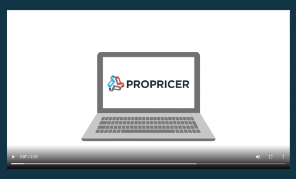Globally, tense geopolitics combined with an ongoing pandemic have created chaos when it comes to supply chain reliability, especially among DoD Agencies.
As a Contractor, you’re no doubt feeling the heat.
The scenario is also fueled by skyrocketing costs, labor shortages, and climate unpredictability. And the degree to which you have to manage your own Contractor supply chain just keeps soaring. 5
The Biden administration wants Contractors to find ways to tighten deliveries. As a government supplier, you would do well to simplify and mitigate the risks inherent in your current procurement structure in order to stay competitive.
This process may temporarily add to your workload, to ensure you’re choosing the correct subs and suppliers—and adequately monitoring their deliveries and their compliance with federal regulations. 1
Sounds tough? You bet it is. But here are five viable approaches that can make supply chain focus worth your while.
Building an ongoing Contractor supply chain task force sets you up for survival
You may need to create a task force made up of representatives from your currently siloed supply-chain functions. Set up a second- or third-shift selection of workers who can check on your supply chain operations and keep things moving as much as possible. If it’s just you, or you and a few other team members, set aside a couple hours late in the day to conduct your supply chain discovery.
The volatility of supply chain snarls isn’t going away anytime soon, so it’s smart to prepare yourself and your staff to make supply chain monitoring and reporting an ongoing initiative. 5
If your supply chain situation is in the least bit complex, a platform like Palantir Foundry can help you digitize every aspect of an end-to-end supply chain in days, and help you see measurable outcomes in a matter of weeks.
Building a resilient Contractor supply chain prepares you for growth
If you’re a manufacturer, making critical components or entire deliverables here in the US is a smart move to sustain growth. The Buy American Act requires the use of certain American-made goods in many government contracts.
Seek out contracts that fall under the Act to boost your supply chain profitability. Additionally, recruit and train workers in your home state. And invest in local research and development that will reduce supply chain vulnerabilities.
Inflation fears are more real now than even in the 1980s. In order to protect margins, you’ll likely have to raise prices. But how much does a unit of product actually cost to produce now? Realize that costs have to happen at the SKU level, and they take a while to propagate through your supply chain system. Don’t be afraid to say “no” to hard-edged, unexpected cost increases. Try to examine them as granularly as you can. 6
If a supplier can’t deliver a raw material on time, how do you know what production is impacted, from both an operations and proposal perspective? The answers are hard to quickly define—unless you’re using ProPricer Contractor Edition—as the data and people responsible for understanding each component may exist throughout your organization.
One solution is to allocate raw material to the most critical areas of a proposal. Another is to redistribute production across your firm. Communicate decisions like these throughout your organization, and to your subs. 2,3,6
Building a secure Contractor supply chain locks in your edge
Here are security best practices you can put to use right away, even if your firm’s supply chain reinvention may not be fully realized:
- Emphasize supply chain security in compliance programs and processes. Incorporating supply chain security into your existing compliance program requires buy-in and effort from various parts of the company such as IT, trade compliance, procurement, human resources, and quality control. This may be just a few people or a few dozen.
- Apply greater vigilance when vetting, selecting, and monitoring subcontractors and suppliers.
- Bolster reporting mechanisms to more effectively detect compliance issues.
- Train internal supply chain stakeholders to deal with existing compliance requirements and to look out for new ones.
- Find out what your competitors are doing and how their Agency customers respond.
Here’s the secret to developing a supply chain compliance advantage: Monitor your current situation, but always look ahead and prepare contingency plans for future compliance fallout you may anticipate from suppliers.4
Building advanced costing into your Contractor supply chain reduces profit loss
Given supply chain fluctuations, you have to be aware of Agency contractual penalties for delivery delays. Unfortunately, as a Contractor you don’t have a voice in determining those clauses, or in how you can still make a profit if you’re found at fault.
To top it off, government Agencies rarely agree to pay Contractors in advance. What to do?
You have to find ways to mitigate the financial risk inherent in supply chain complications. For instance, you might have to outlay funds upfront for supplies to complete a contract that will not be paid for by the Government until final delivery, months down the road. Line up your financing now, and cover your exposure.6
Building platform compatibility into your proposal can speed cost approvals
If you’re submitting proposals in a format that’s compatible with Agency review cycles, as with ProPricer Contractor Edition, you can protect yourself from supply chain risks by helping your Agency approve costs and pricing more quickly. This lets you secure needed financing faster and lock in pricing before your component manufacturers or subs start to feel greater supply chain risk on their respective ends.
The platform can also help you verify subcontractor performance, by flagging certification- clause compliance issues or signaling what may require a mandatory audit. Speaking of audits: Your own audit by an Agency can benefit greatly from the extensive documentation ProPricer helps you produce.
If you’re a smaller manufacturer or services Contractor, try ProPricer Contractor Edition - Essentials for a full 30 days, absolutely free.
This should be enough time to complete at least one proposal using the platform. See how the power of ProPricer can help you automate your analysis and reporting, adjust costs and pricing on the fly, use legacy data from prior proposals to your advantage, and quickly shift delivery dates if needed.
Already tried and ready to buy? Gain maximum efficiency in proposal pricing and Contractor supply chain management with ProPricer Contractor Edition.
Government Contract Pricing Summit is back for the first time since 2019
We’re picking up where we left off and returning live and in-person for our 7th Anniversary on June 14th, 2022. Centrally located, and steps away from Harbor Island, the majestic waterfront Sheraton San Diego Hotel and Marina is the place to be to recharge and grow with strategic breakout sessions and inclusive networking opportunities.
It’s your time to reconnect with peers and leading representatives in the industry. All work and no play? We don’t think so either. After engaging sessions hosted by GovCon thought leaders, take advantage of the proximity to the USS Midway Museum and nearby attractions for an unforgettable post-pandemic send off into summer!
Sources
- RSM Article: Defense supply chain for government contractors is under a microscope
- Executive Order on America’s Supply Chains
- 100 Day Reviews on Executive Order 141017: Building Resilient Supply Chains
- Crowell Article: Government Contracts – A Secure Supply Chain Is a Competitive Advantage
- Palantir Whitepaper: Palantir Foundry for Supply Chains
- Womble, Bond, Dickinson Article: Government Contract Challenges and Opportunities … with the Supply Chain




